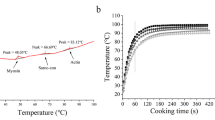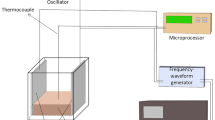Abstract
Electrical conductivities (ECs) of ordinary (white) and dark (red) muscles of yellowtail (Seriola quinqueradiata) fillets were measured at frequencies between 50 and 20,000 Hz from 15 to 80 °C to provide insights into improving the modeling of continuous ohmic heating (OH) in fish products. The effects of temperature, muscle types (ordinary and dark), muscle composition (moisture and fat content), muscle and current direction (parallel and series), and muscle membrane on EC were investigated during OH. At 20 kHz, the ECs of yellowtail fillets increased linearly with increasing temperature (p < 0.01). Compared with the dark muscle (moisture content 60.4 ± 1.6 %, fat content 18.7 ± 2.1 %), the ordinary muscle (moisture content 63.5 ± 1.0 %, fat content 7.3 ± 0.9 %) has a high EC value. The parallel type (direction of current in fish) of yellowtail fillets has a higher EC value than the series type. The EC of the minced yellowtail is in between the value of the two types of muscles. Temperature, fat and moisture contents, and current direction all influenced the EC, and especially the muscle membrane connecting fiber has a major influence on EC of two different types of muscles. The thickness and EC of muscle membrane were measured and calculated using magnetic resonance imaging and simultaneous equations, respectively. The calculated values were compared with the experimental values; the correlation coefficients of all samples were above 0.99, and the relative root mean square error and maximum relative error values demonstrated that both values are in good agreement.










Similar content being viewed by others
References
An, H. J., & King, J. M. (2007). Thermal characteristics of ohmically heated rice starch and rice flours. Journal of Food Science, 72, 84–88.
Arockiadoss, T., Xavier, F. P., Karthikeya Prabhu, B., & Babu, M. (2008). Electrical conductivity as a tool for identification of meat contaminated fish protein. Journal of Food Engineering, 88, 405–410.
Assiry, A. M., Sastry, S. K., & Samaranayake, C. (2003). Degradation kinetics of ascorbic acid during ohmic heating with stainless steel electrodes. Journal of Applied Electrochemistry, 33, 187–196.
Assiry, A. M., Gaily, M. H., Alsamee, M., & Sarifudin, A. (2010). Electrical conductivity of seawater during ohmic heating. Desalination, 260, 9–17.
Bae, J. H., Hwang, S. Y., Yoon, S. H., Noh, I., & Lim, S. Y. (2011). Comparison between ordinary and dark muscle extracts of yellowtail (Serila quinqueradiata) on chemical characteristics, antiproliferative and antioxidant properties. Journal of Food Technology, 9, 99–105.
Bozkurt, H., & Icier, F. (2010). Exergetic performance analysis of ohmic cooking process. Journal of Food Engineering, 100, 688–695.
Cardello, A. V., Schutz, H. G., & Lesher, L. L. (2007). Consumer perceptions of foods processed by innovative and emerging technologies: a conjoint analytic study. Innovative Food Science & Emerging Technologies, 8, 73–83.
Castro, I., Teixeira, J. A., & Vicente, A. A. (2003). The influence of field strength, sugar and solid content on electrical conductivity of strawberry products. Journal of Food Process Engineering, 26, 17–29.
Castro, I., Teixeira, J. A., Salengke, S., Sastry, S. K., & Vicente, A. A. (2004). Ohmic heating of strawberry products: electrical conductivity measurements and ascorbic acid degradation kinetics. Innovative Food Science and Emerging Technologies, 5, 27–36.
Chevalier, D., Ossart, F., & Ghommidh, C. (2006). Development of non-destructive salt and moisture measurement method in salmon (salmo salar) fillets using impedance technology. Food Control, 17, 342–347.
Cliff, M. A., Li, J. B., Toivonen, P. M. A., & Ehret, D. L. (2012). Effects of nutrient solution electrical conductivity on the compositional and sensory characteristics of greenhouse tomato fruit. Postharvest Biology and Technology, 74, 132–140.
Dai, Y., Miao, J., Yuan, S. Z., Liu, Y., Li, X. M., & Dai, R. T. (2013). Colour and sarcoplasmic protein evaluation of pork following water bath and ohmic cooking. Meat Science, 93, 898–905.
Dai, Y., Lu, Y., Wu, W., Lu, X., Han, Z., Liu, Y., Li, X., & Dai, R. (2014). Changes in oxidation, color and texture deteriorations during refrigerated storage of ohmically and water bath-cooked pork meat. Innovative Food Science & Emerging Technologies, 26, 341–346.
Darvishi, H., Khostaghaza, M. H., & Najafi, G. (2013). Ohmic heating of pomegranate juice: Electrical conductivity and pH change. Journal of the Saudi Society of Agricultural Sciences, 12, 101–108.
Heising, J. K., Bartels, P. V., van Boekel, M. A. J. S., & Dekker, M. (2014). Non-destructive sensing of the freshness of packed cod fish using conductivity and pH electrodes. Journal of Food Engineering, 124, 80–85.
Icier, F., & Ilicali, C. (2005). Temperature dependent electrical conductivities of fruit purees during ohmic heating. Food Research International, 38, 1135–1142.
Ishiwatari, N., Fukuoka, M., & Sakai, N. (2013). Effect of protein denaturation degree on texture and water state of cooked meat. Journal of Food Engineering, 117, 361–369.
Knirsch, M. C., Santos, C. A., Martins, A. A., Vicente, O. S., & Penna, T. C. V. (2010). Ohmic heating-a review. Trends in Food Science & Technology, 21, 436–441.
Kong, F., Tang, J., & Crapo, C. (2007). Kinetic of salmon quality changes during thermal processing. Journal of Food Engineering, 83, 510–520.
Kusnadi, C., & Sastry, S. K. (2012). Effect of moderate electric fields on salt diffusion into vegetable tissue. Journal of Food Engineering, 110, 329–336.
Lantry, B. F., & Stewart, D. J. (1999). Evaluation of total-body electrical conductivity to estimate whole-body water content of yellow perch Perca flavescens, and alewife, Alosa pseudoharengus. Fishery Bulletin, 97, 71–79.
Liu, S., Ogiwara, Y., Fukuoka, M., & Sakai, N. (2014). Investigation and modeling of temperature changes in food heated in a flatbed microwave oven. Journal of Food Engineering, 131, 142–153.
Liu, X., Jiang, Y., Shen, S., Luo, Y., & Gao, L. (2015). Comparison of Arrhenius model and artificial neuronal network for the quality prediction of rainbow trout (Oncorhynchus mykiss) fillets during storage at different temperatures. LWT--Food Science and Technology, 60, 142–147.
McKenna, B. M., Lying, J., Brunton, N., & Shirsat, N. (2006). Advances in radio frequency and ohmic heating of meats. Journal of Food Engineering, 77, 215–229.
Moreno, J., Simpson, R., Sayas, M., Segura, I., Aldana, O., & Almonacid, S. (2011). Influence of ohmic heating and vacuum impregnation on the osmotic dehydration kinetics and microstructure of pears (cv. Packham’s Triumph). Journal of Food Engineering, 104, 621–627.
Moreno, J., Simpson, R., Baeza, A., Morales, J., Munoz, C., Sastry, S., & Almonacid, S. (2012). Effect of Ohmic heating and vacuum impregnation on the osmodehydration kinetics and microstructure of strawberries (cv. Camarosa). LWT--Food Science and Technology, 45, 148–154.
Norberg, E. (2005). Electrical conductivity of milk as a phenotypic and genetic indicator of bovine mastitis: A review. Livestock Production Science, 96, 129–139.
Ofstad, R., Kidman, S., & Hermansson, A. M. (1993). Liquid holding capacity and structure changes during heating of fish muscle; cod (Gadus morhua L.) and salmon (Salmo salar). Food structure, 12, 163–174.
Palaniappan, S., & Sastry, S. K. (1991). Electrical conductivities of selected solid foods during ohmic heating. Journal of Food Process Engineering, 14, 221–236.
Park, S. H., Balasubramaniam, V. M., & Sastry, S. K. (2013). Estimating pressure induced changes in vegetable tissue using in situ electrical conductivity measurement and instrumental analysis. Journal of Food Engineering, 114, 47–56.
Park, S. H., Balasubramaniam, V. M., & Sastry, S. K. (2014). Quality of shelf-stable low-acid vegetables processed using pressure–ohmic–thermal sterilization. LWT--Food Science and Technology, 57, 243–252.
Piette, G., Buteau, M. L., De Halleux, D., Chiu, L., Raymond, Y., & Ramaswamy, H. S. (2004). Ohmic heating of processed meat and its effect on product quality. Journal of Food Science, 69, 71–77.
Pongviratchai, P., & Park, J. K. (2007). Electrical conductivity and physical properties of Surimi-Potato starch under ohmic heating. Journal of Food Science, 72, 503–507.
Prasad-Thakur, D., Morioka, K., Itoh, Y., & Obatake, A. (2003). Lipid composition and deposition of cultured yellowtail Seriola quinqueradiata muscle at different anatomical locations in relation to meat texture. Fisheries Science, 69, 487–494.
Romvári, R., Hancz, C. S., Petrási, Z. S., Molnár, T., & Horn, P. (2002). Non-invasive measurement of fillet composition of four freshwater fish species by computer tomography. Aquaculture International, 10, 231–240.
Sakr, M., & Liu, S. (2014). A comprehensive review on application of ohmic heating (OH). Renewable and Sustainable Energy Reviews, 39, 262–269.
Salengke, S., & Sastry, S. K. (2007). Experimental investigation of ohmic heating of solid-liquid mixtures under worst-case heating scenatios. Journal of Food Engineering, 83, 324–336.
Sarang, S., Sastry, S. K., & Knipe, L. (2008). Electrical conductivity of fruits and meats during ohmic heating. Journal of Food Engineering, 87, 351–356.
Sastry, S. K., & Barach, J. T. (2000). Ohmic and inductive heating. Journal of Food Science, 65, 42–46.
Seno-o, A., Takakuwa, F., Hashiguchi, T., Morioka, K., Masumoto, T., & Fukada, H. (2008). Replacement of dietary fish oil with olive oil in young yellowtail Seriola quinqueradiata: effect on growth, muscular fatty acid composition and prevention of dark muscle discoloration during refrigerated storage. Fisheries Science, 74, 1297–1306.
Shioya, I., Takemura, S., Ishizuka, R., & Yamaguchi, T. (2012). Variations in the proximate composition of muscle in cultured yellowtail Seriola quinqueradiata at different anatomical portions. Fisheries Science, 78, 725–733.
Shirsat, N., Lyng, J. G., Brunton, N. P., & McKenna, B. (2004). Ohmic processing: electrical conductivities of pork cuts. Meat Science, 67, 507–514.
Skipnes, D., Plancken, I. V., Loey, A. V., & Hendrickx, M. E. (2008). Kinetics of heat denaturation of proteins from farmed Atlantic cod (Gadus morhua). Journal of Food Engineering, 85, 51–58.
Stancl, J., & Zitny, R. (2010). Milk fouling at direct ohmic heating. Journal of Food Engineering, 99, 437–444.
Vicente, A. A., Castro, I., & Teixeira, J. A. (2006). Innovations in thermal food processes. In D.-W. Sun (Ed.), Thermal food processing: new technologies and quality issues (pp. 424–468). Boca Raton: CRC Press, Taylor & Francis Group.
Wang, C. S., Kuo, S. Z., Kuo-Huang, L. L., & Wu, J. S. B. (2001). Effect of tissue infrastructure on electric conductance of vegetable stems. Journal of Food Science, 66, 284–288.
Wang, Y., Tang, J., Rasco, B., Kong, F., & Wang, S. (2008). Dielectric properties of salmon fillets as a function of temperature and composition. Journal of Food Engineering, 87, 236–246.
Watanabe, H., & Fukuoka, M. (1992). Measurement of moisture diffusion in foods using pulsed field gradient NMR. Trends in Food Science and Technology, 3, 211–215.
Wu, H., Kolbe, E., Flugstad, B., Park, J. W., & Yongsawatdigul, J. (1998). Electrical properties of fish mince during multi-frequency ohmic heating. Journal of Food Science, 63, 1028–1032.
Yao, L., Luo, Y., Sun, Y., & Shen, H. (2011). Establishment of kinetic models based on electrical conductivity and freshness indictors for the forecasting of crucian carp (Carassius carassius) freshness. Journal of Food Engineering, 107, 147–151.
Yildiz-Turp, G., Sengun, I. Y., Kendirci, P., & Icier, F. (2013). Effect of ohmic treatment on quality characteristic of meat: a review. Meat Science, 93, 441–448.
Zell, M., Lyng, J. G., Cronin, D. A., & Morgan, D. J. (2009a). Ohmic cooking of whole beef muscle-optimization of meat preparation. Meat Science, 81, 693–698.
Zell, M., Lyng, J. G., Cronin, D. A., & Morgan, D. J. (2009b). Ohmic heating of meats: Electrical conductivities of whole meats and processed meat ingredients. Meat Science, 83, 563–570.
Zell, M., Lyng, J. G., Morgan, D. J., & Cronin, D. A. (2009c). Development of rapid response thermocouple probes for use in a batch ohmic heating system. Journal of Food Engineering, 93, 344–347.
Acknowledgments
This work was supported by the personnel development plan of Shanghai Municipal Education Commission, Science and Technology Commission of Shanghai Municipality (12290502200) and Shanghai University Knowledge Service Platform and Shanghai Ocean University Aquatic Animal Breeding Center (ZFI206).
Author information
Authors and Affiliations
Corresponding author
Rights and permissions
About this article
Cite this article
Jin, Y., Cheng, Yd., Fukuoka, M. et al. Electrical Conductivity of Yellowtail (Seriola quinqueradiata) Fillets During Ohmic Heating. Food Bioprocess Technol 8, 1904–1913 (2015). https://doi.org/10.1007/s11947-015-1546-4
Received:
Accepted:
Published:
Issue Date:
DOI: https://doi.org/10.1007/s11947-015-1546-4




